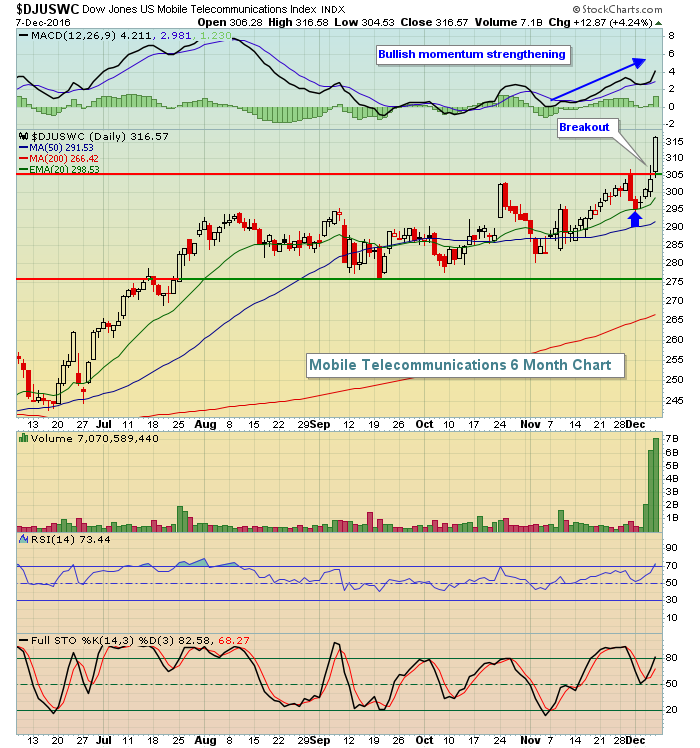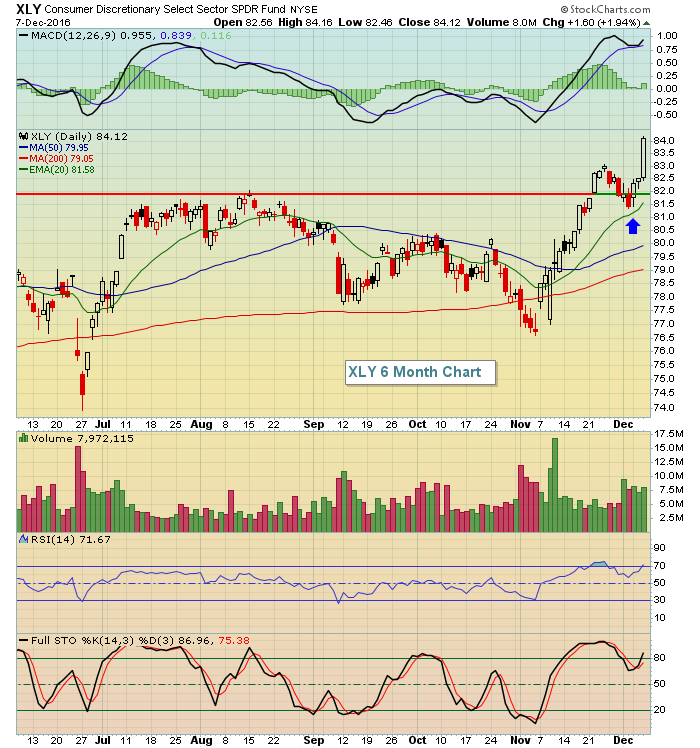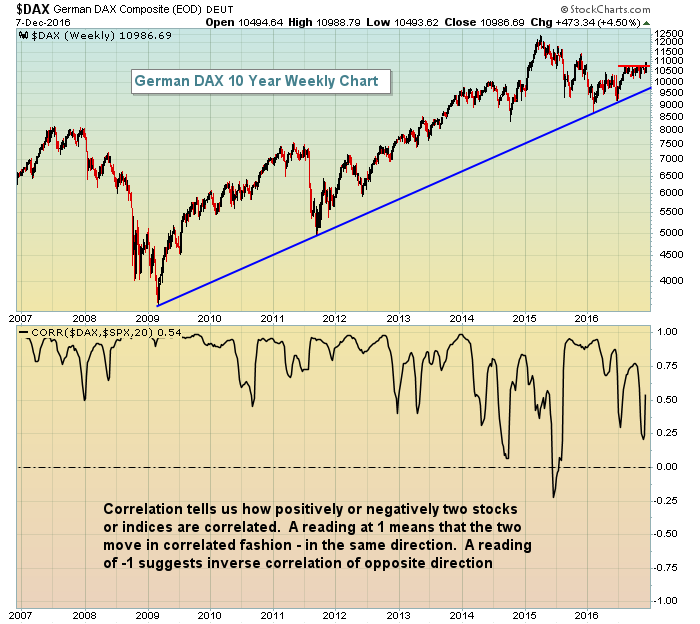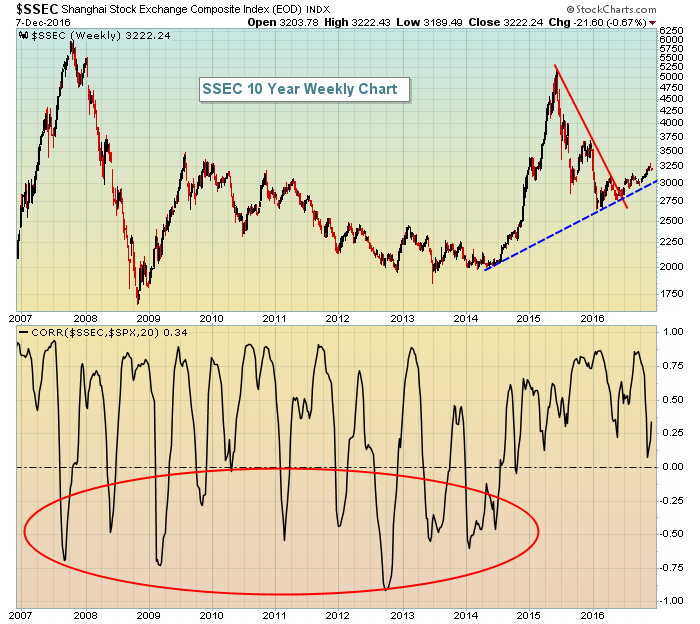Market Recap for Wednesday, December 7, 2016
Money poured into risk yesterday as global markets rallied in anticipation of strengthening economies worldwide. Here in the U.S., nearly every single industry group pushed higher, many of them 1%-2% higher or more. Significant leadership came in the form of consumer discretionary (XLY, +1.94%), technology (+1.90%), industrials (XLI, 1.86%) and financials (XLF, +1.56%). While we saw relative weakness in technology for awhile, which spooked traders a bit, that sector is now bouncing back strongly with mobile telecommunication stocks ($DJUSWC) clearing overhead resistance on heavy volume. Check out the bullish view here:
 While the bullishness in technology was apparent, so too was it in consumer discretionary where the XLY broke out to another fresh high after testing its rising 20 day EMA in bullish fashion. Check out the strength here:
While the bullishness in technology was apparent, so too was it in consumer discretionary where the XLY broke out to another fresh high after testing its rising 20 day EMA in bullish fashion. Check out the strength here:
 After the breakout in late November above 82, I look for pullbacks to hold at one of two places. The first is price support at 82 as broken price resistance becomes price support. You can see that the XLY temporarily dipped just beneath that price support, but the rising 20 day EMA (2nd support level) held nicely and now the XLY has once again broken out. This is very bullish action and the backdrop in equities really couldn't be much stronger right now.
After the breakout in late November above 82, I look for pullbacks to hold at one of two places. The first is price support at 82 as broken price resistance becomes price support. You can see that the XLY temporarily dipped just beneath that price support, but the rising 20 day EMA (2nd support level) held nicely and now the XLY has once again broken out. This is very bullish action and the backdrop in equities really couldn't be much stronger right now.
Failing to cooperate on Wednesday was the healthcare sector (XLV, -0.86%), which was the only sector to finish in negative territory. Biotechnology stocks ($DJUSBT) were the drag, losing 2.37%, but four of the five industry groups in healthcare lost ground. So it wasn't totally because of biotechs.
Pre-Market Action
The big news this morning is coming out of Europe where the European Central Bank (ECB) has announced its latest intention of extending its bond-buying program. The quantitative easing program will continue at 80 billion euros through March 2017, at which time there will be a decrease to 60 billion euros for the balance of 2017, or 9 additional months. European markets initially felt a shock, but have since recovered nicely as the German DAX has added another 1.17% to 11115 this morning.
Here in the U.S., the reaction had been fairly muted, but now the Dow Jones futures are up by 41 points as Wall Street braces for another nice open.
Current Outlook
Germany ($DAX) confirmed its latest breakout on Wednesday's close and that adds to the bullish environment for global equities. I love to see solid performance in the DAX because it's the index that most highly correlated with U.S. equities. First, check out the correlation between the DAX and SPX and then compare it to the correlation between the China Shanghai ($SSEC) and the SPX:
DAX vs. SPX
 Note a couple things here. First, the DAX rallied off March 2009 lows, just as did the S&P 500. Also note that the long-term trendline on the DAX has held beautifully and the move above 10800 yesterday cleared an important price resistance level in 2016. I believe the DAX will now perform much stronger with an initial target of 11500. At the bottom of this chart, you can see that the correlation between the DAX:SPX has been almost exclusively in positive territory over thhe past 10 years. That suggests that what's good for one is good for the other. Thus, the continuation in the bullish pattern in Germany will only add to the strength here in the U.S. and vice versa.
Note a couple things here. First, the DAX rallied off March 2009 lows, just as did the S&P 500. Also note that the long-term trendline on the DAX has held beautifully and the move above 10800 yesterday cleared an important price resistance level in 2016. I believe the DAX will now perform much stronger with an initial target of 11500. At the bottom of this chart, you can see that the correlation between the DAX:SPX has been almost exclusively in positive territory over thhe past 10 years. That suggests that what's good for one is good for the other. Thus, the continuation in the bullish pattern in Germany will only add to the strength here in the U.S. and vice versa.
Many times, U.S. traders react to what's happening in Asia, particularly in China. While that may make sense fundamentally, it bears little relevance technically. Check out the correlation between U.S. stocks and China stocks:
SSEC vs SPX
 There's a little different picture here, wouldn't you agree? Yes, the SSEC is currently strengthening in a nice uptrend and the correlation the past couple years has been positive, but check out all the negative correlation from 2007 to 2014. We can't really rely on happenings in China to help us determine direction of equities here in the U.S. That's why I cringe when I hear analysts trying to determine our market's future based on economic developments there.
There's a little different picture here, wouldn't you agree? Yes, the SSEC is currently strengthening in a nice uptrend and the correlation the past couple years has been positive, but check out all the negative correlation from 2007 to 2014. We can't really rely on happenings in China to help us determine direction of equities here in the U.S. That's why I cringe when I hear analysts trying to determine our market's future based on economic developments there.
Sector/Industry Watch
I mentioned above the weakness felt in healthcare yesterday. The good news is there was a price reversal at a key price level that suggests we could see a short-term rally in this beaten down sector. Check out the XLV chart and the doji that printed on Wednesday:
 This doji printed after an extended downtrend and the reversal occurred at its first key price support level. Not pictured above is the weekly chart where the XLV has been consolidating in bullish sideways fashion since topping in the summer of 2015. The current longer-term range is approximately 63-76. So the current price of 67.89 is toward the lower end of the range and any further weakness actually would become a compelling entry for a longer-term swing trade. Remember: during bull markets, temporary declines many times turn out to be great buying opportunities. Just check out technology over the past few weeks.
This doji printed after an extended downtrend and the reversal occurred at its first key price support level. Not pictured above is the weekly chart where the XLV has been consolidating in bullish sideways fashion since topping in the summer of 2015. The current longer-term range is approximately 63-76. So the current price of 67.89 is toward the lower end of the range and any further weakness actually would become a compelling entry for a longer-term swing trade. Remember: during bull markets, temporary declines many times turn out to be great buying opportunities. Just check out technology over the past few weeks.
Historical Tendencies
Yesterday I highlighted the upcoming bearish period in December for small cap stocks (Russell 2000). Today I'm featuring the same analysis by calendar day for the NASDAQ. Check it out:
December 7: -21.79%
December 8: +35.47%
December 9: -45.51%
December 10: +45.20%
December 11: -108.23%
December 12: -40.43%
December 13: -91.76%
December 14: -99.48%
December 15: -51.72%
These daily annualized returns are much worse once we hit December 11th. The 7th through 10th are mostly flat. Keep in mind that historical patterns are secondary to technical conditions, which are very bullish right now. Therefore, I'm not overly concerned the next couple days. Those historically weak numbers next week could be problematic, however, especially if overbought conditions worsen prior to the weekend.
Key Earnings Reports
(actual vs. estimate):
SAIC: .91 vs .84
TTC: .27 vs .22
(reports after close, estimate provided):
AVGO: 2.89
COO: 2.24
FNSR: .38
Key Economic Reports
Initial jobless claims released at 8:30am EST: 258,000 (actual) vs. 255,000 (estimate)
Happy trading!
Tom






